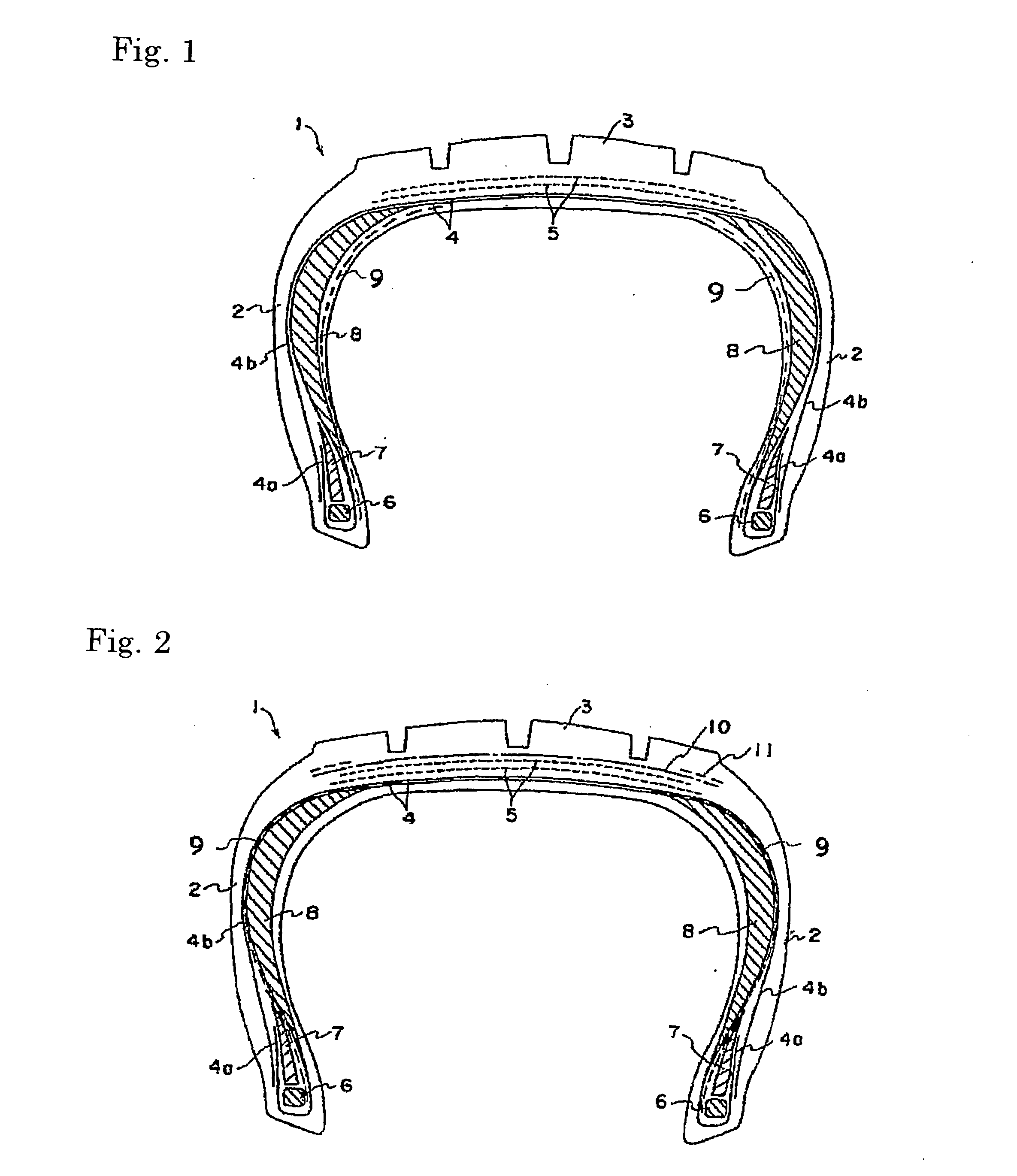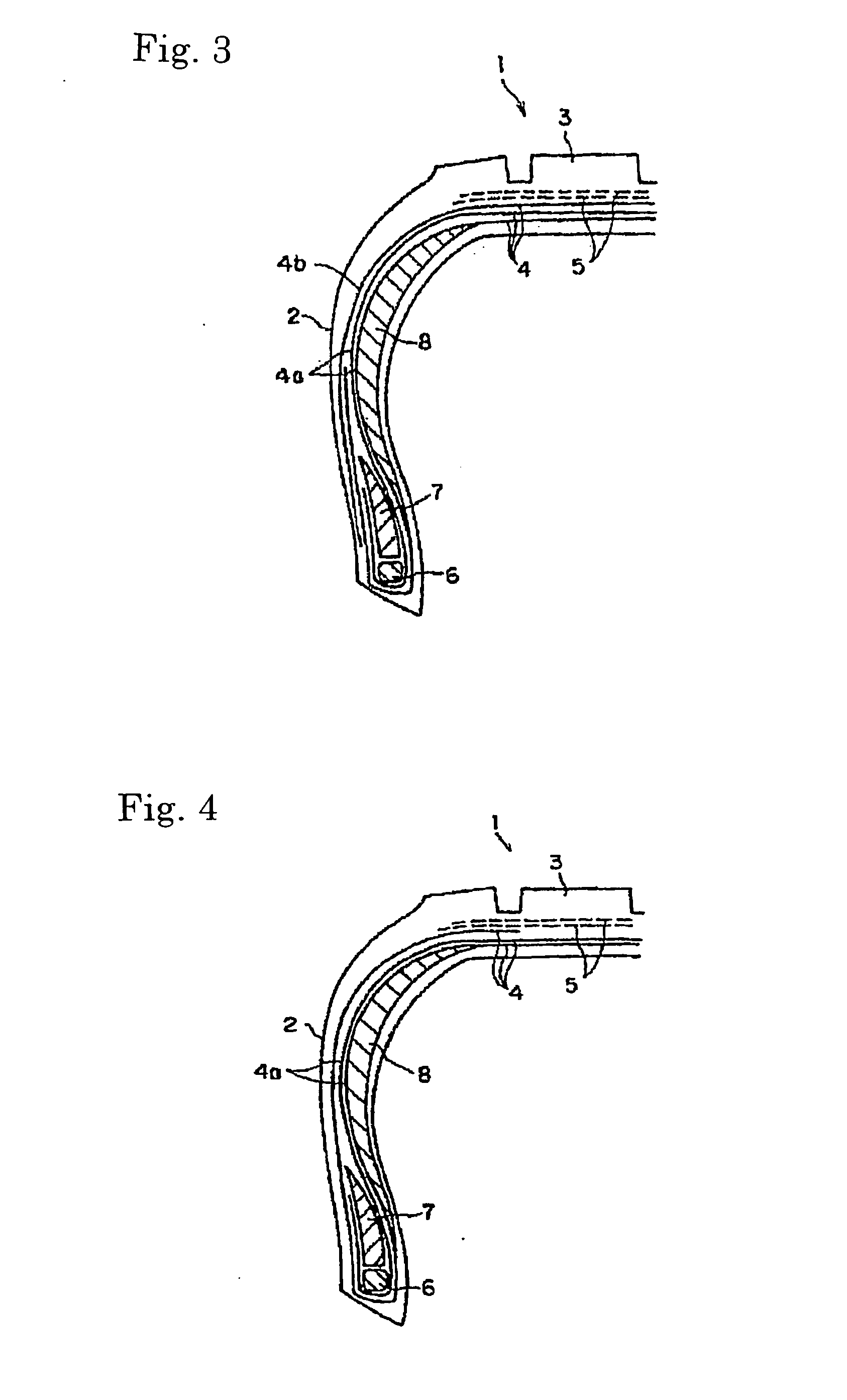Pneumatic tire
a technology of pneumatic tires and skeleton parts, which is applied in the field of pneumatic tires, can solve the problems of reduced internal pressure of tires to atmospheric pressure, almost complete loss of tension formed in the skeleton portion of tires, and loss of braking performance and turning performance, so as to achieve excellent ride comfort and excellent durability
- Summary
- Abstract
- Description
- Claims
- Application Information
AI Technical Summary
Benefits of technology
Problems solved by technology
Method used
Image
Examples
examples
[0172] The present invention will be described more specifically with reference to examples in the following. However, the present invention is not limited to the examples.
[0173] Various measurements were conducted by the following methods.
(1) Microstructure of a Polymer
[0174] The content of vinyl linkages in the portion of conjugated diene units (the 1,2-structure in the butadiene portion) was obtained by the infrared spectroscopy (the Morero's method).
(2) Physical Properties of a Vulcanized Rubber Composition [Dynamic Storage Modulus (E′)]
[0175] From a slab sheet having a thickness of 2 mm which was obtained by vulcanizing a rubber composition under the condition of 160° C. for 12 minutes, a sheet having a width of 5 mm and a length of 40 mm was cut out and used as the sample. Using the obtained sample, the dynamic storage modulus (E′) was measured under the condition of a distance between clamps of 10 mm, an initial strain of 200 micrometers (microns), a dynamic strain of 1...
preparation examples 1 to 18
BR-based polymers A, B, I to X; Batch Polymerization
[0218] Into a 8 liter pressure-resistant reactor having a jacket for adjusting the temperature, the reactor which had been dried and purged with nitrogen, 3 kg of cyclohexane, 500 g of butadiene monomer and 0.225 mmole of ditetrahydrofurylpropane (DTHFP) were placed. After 4.5 mmole of n-butyllithium (BuLi) was added to the resultant mixture, the polymerization was allowed to proceed at an initial temperature of 40° C. for 1 hour. The polymerization was allowed to proceed while the temperature was elevated and the temperature in the jacket was adjusted so that the final temperature of the reaction system did not exceed 75° C. The polymerization system was completely homogeneous and transparent without precipitates from the start to the end of the polymerization. The conversion of the polymerization was about 100%.
[0219] To the obtained polymerization system, 0.11 ml of SnCl4 (TTC, a 1 M cyclohexane solution) was added as the end ...
preparation examples 19 to 21
BR-Based Polymers Y, Z and AA; Batch Polymerization, Using a Modifying Initiator
[0223] Into a 8 liter pressure-resistant reactor having a jacket for adjusting the temperature, the reactor which had been dried and purged with nitrogen, 3 kg of cyclohexane, 500 g of butadiene monomer and 1.6 mmole of ditetrahydrofurylpropane (DTHFP) were placed. After 4 mmole of n-butyllithium (BuLi) was added to the resultant mixture, 0.8 mmole of hexamethyleneimine (HMI) was quickly added and the polymerization was allowed to proceed at an initial temperature of 40° C. for 1 hour. The polymerization was allowed to proceed while the temperature was elevated and the temperature in the jacket was adjusted so that the final temperature of the reaction system did not exceed 75° C. The polymerization system was completely homogeneous and transparent without precipitates from the start to the end of the polymerization. The conversion of the polymerization was about 100%.
[0224] To the obtained polymerizat...
PUM
| Property | Measurement | Unit |
|---|---|---|
| Temperature | aaaaa | aaaaa |
| Temperature | aaaaa | aaaaa |
| Fraction | aaaaa | aaaaa |
Abstract
Description
Claims
Application Information
 Login to View More
Login to View More - R&D
- Intellectual Property
- Life Sciences
- Materials
- Tech Scout
- Unparalleled Data Quality
- Higher Quality Content
- 60% Fewer Hallucinations
Browse by: Latest US Patents, China's latest patents, Technical Efficacy Thesaurus, Application Domain, Technology Topic, Popular Technical Reports.
© 2025 PatSnap. All rights reserved.Legal|Privacy policy|Modern Slavery Act Transparency Statement|Sitemap|About US| Contact US: help@patsnap.com



